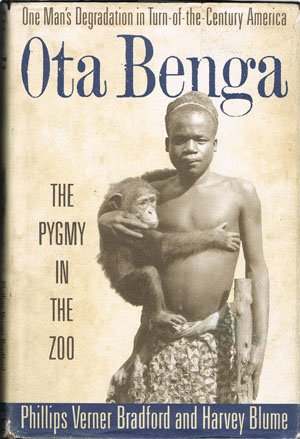Throughout the years many of these stories crossed my path.
Of Ota Benga, for example, a Mbuti pygmy from Congo who travelled to the US with the reverend dr. Samuel Phillips Verner to be exhibited at the 1904 Saint Louis Fair.
Phillips Verner Bradford, historian and grandson of the reverend-explorer, wrote the book ‘Ota Benga, the pygmee in the zoo. One man’s degradation in Turn-of-the-Century Amerika,’ in which he took a dive into the archives to retrieve Ota Benga’s path. The story is amazing.
Ota Benga’s journey started after his family (wife and children) had been murdered by the Forces Publiques. Verner bought him from slave traders. Ota quickly developed as a leader of the expidition and as a personal friend to Verner. For 5 cents, Ota Benga showed his pointed teeth to the visitors of the St Louis Fair. After the fair, Ota Benga returned with Verner and the other pygmies (of a different tribe, the Batwa) to Congo. Later he preferred to return to America with Verner. He got food and housing at the New York Museum of Natural History, until he threw a chair at someones head. He was then transferred to the Bronx Zoo where he stayed at the monkey house, practiced shooting with bow and arrow and took care of a small orangutang. Because of loud protests, the zoo had to let him go. Verner was out of money and found a place for Ota at an orphanage. There, Ota learned English and received caps to hide his pointed teeth. Later he took a job as a succesful tobacco harvester and he started planning his return to Africa. The first world war made these plans impossible. Ota Benga became unhappy. On the 20th march 1916 he lighted a ritual fire, chipped the caps off his teeth and shot himself in the heart with a gun he stole.
When I finally found the Ota Benga book at Strand Book Store in New York, I was the happiest person. Don’t laugh, it was 2001 and Amazon was not as all-present as today.
Ota Benga was, according to all descriptions, a rather cheerful young man.
One detail is very unsettling, even spooky, if we remember the ‘Nigger in the shrank’-story:
‘He (Ota Benga) had an image of himself stuffed, behind glass, but somehow still alive, crouching over a fake campfire, feeding meat to a lifeless child.'(p166)
It seems as if he knew the story of ‘The nigger in the shrank’ , or as if he connected with it one way or another. Maybe that is not so strange; the vision came to him at the time he spent in the Museum of Natural History.
The chapter about the Saint Louis Fair brings to my attention that the exhibited formed a community in itself. Ota Benga for example became friends with Geronimo, the exhibited Apache leader, who sold arrowheads, photographs and autographs to the visitors. He offered Ota Benga an arrowhead.
Unfortunately, we know very little about these friendships. The exhibited have not written down their experiences. In his memoirs, Geronimo describes a few shows of the fair, but says nothing about Ota Benga.
I would really like to know how it was from the inside: how the friendships developed, how they would communicate, what would they say?



